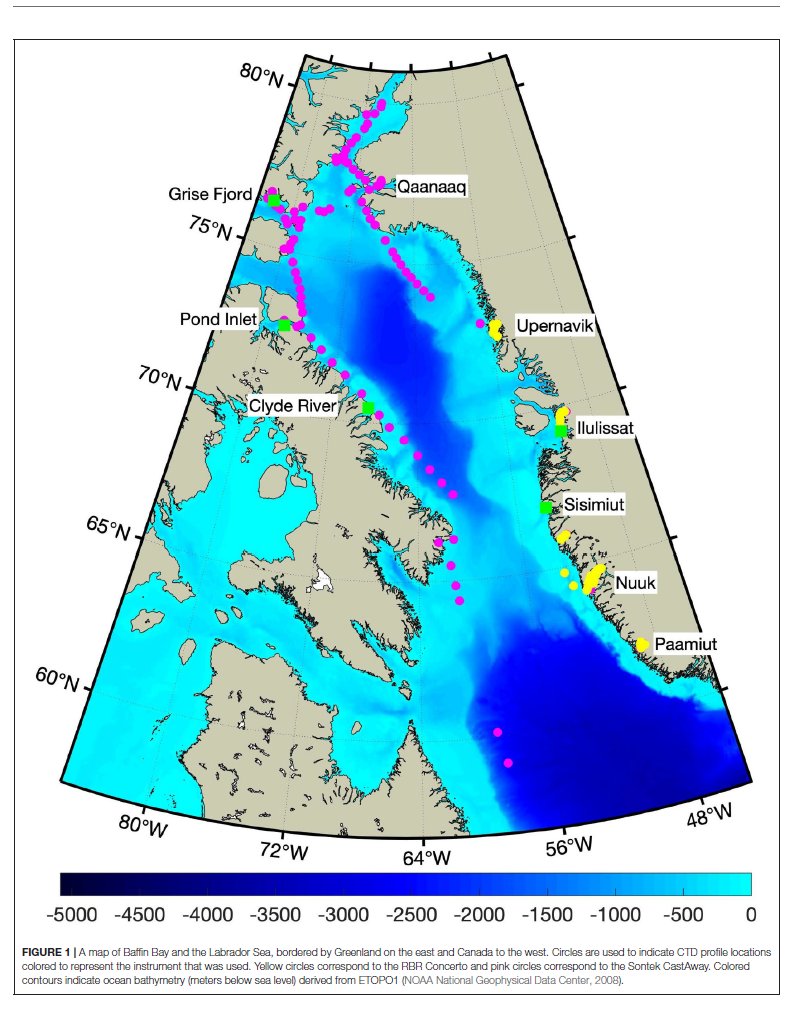The 2017 Mission Arctic Citizen Science Sailing Expedition Conductivity, Temperature, and Depth Profiles in Western Greenland and Baffin Bay
New publication by Daniel F. Carlson, Gareth Carr, J. L. Crosbie, Peter Lundgren, Nicolas Peissel, Pippa Pett, Will Turner and Søren Rysgaard

Abstract:
The density of polar waters is controlled by salinity,making the so-called “beta oceans” (Carmack, 2007). Changes in salinity, therefore, can alter stratification, which impacts of a host of physical and biogeochemical processes in beta oceans (Carmack, 2007; Brown et al., 2020). Mass loss from the Greenland Ice Sheet has increased by a factor of six since the 1980s (Mouginot et al., 2019) and freshwater runoff into adjacent fjord and shelf waters has subsequently increased (Sejr et al., 2017; Boone et al., 2018; Moon et al., 2018; Mankoff et al., 2020). The increase in freshwater discharge impacts marine ecosystems (Meire et al., 2017; Cape et al., 2019; Seifert et al., 2019; Hopwood et al., 2020; Oliver et al., 2020), and density stratification and circulation in fjords and Baffin Bay (Castro de la Guardia et al., 2015; Sejr et al., 2017; Boone et al., 2018; Moon et al., 2018; Monteban et al., 2020; Rysgaard et al., 2020). The contribution of freshwater runoff from the Greenland Ice Sheet to the freshening observed in the North Atlantic remains an area of active research that relies heavily on numerical ocean models (Liu et al., 2018; Dukhovskoy et al., 2019; Zhang et al., 2021). Synoptic hydrographic observations can aid in quantifying the magnitude and spatial distribution of glacial meltwater in fjord and ocean waters around Greenland to provide much-needed benchmarks for ocean models that attempt to simulate the effects of this added freshwater on ocean circulation, heat transport, and climate (Gillard et al., 2016; Little et al., 2016; Dukhovskoy et al., 2019). Observations in remote and harsh Arctic environments can be difficult and costly. Additionally, the number of research vessels that operate in Greenlandic waters are limited and are highly sought after. Sailboats have been used as measurement platforms in the region (Miller et al., 1995; Karnovsky et al., 2010; Johannessen et al., 2011; Fenty et al., 2016; Nicoli et al., 2018; Aliani et al., 2020; Bouchard et al., 2020) andmarinemonitoring programs should leverage the increase in Arctic tourism aboard cruise ships and private yachts (Dawson, 2019; Leoni, 2019; Palma et al., 2019) to increase the spatiotemporal coverage of ocean observations in Greenlandic waters.While sailboats lack the resources of dedicated research vessels, they are small, maneuverable, and flexible, and therefore, are well-suited for citizen science (Simoniello et al., 2019). Here, we present a pilot project that demonstrated the ability of citizen scientists aboard a sailboat to independently acquire hydrographic data in remote marine environments that are impacted by glacial runoff. The Mission Arctic citizen science sailing expedition collected profiles of temperature and salinity from July to September 2017 in the upper ∼60 m of the water column in western Greenland, Nares Strait, and Baffin Bay (Figure 1). This report describes the expedition, hydrographic data collection and quality control procedures, the final data set, and presents preliminary results.
doi: 10.3389/fmars.2021.665582
